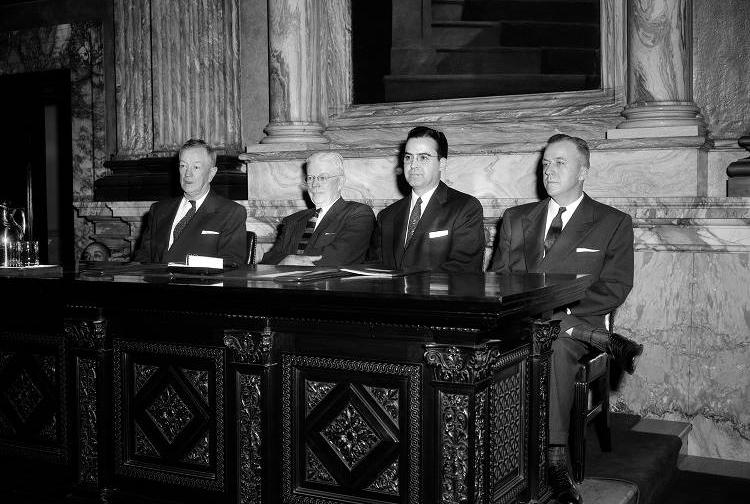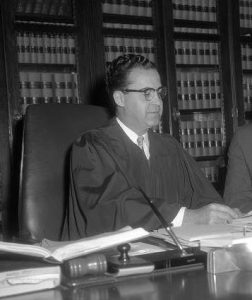(Oct. 18, 1913-Mar. 8, 1995). Born in Mount Vernon, Indiana William E. Steckler earned a law degree at Indiana University School of Law in 1936. The following year he received a doctorate in law and went into private practice in Indianapolis from 1937-1950.
Steckler’s civic engagement included national, state, and local service. He served in the Naval Reserve in 1943. His activity in the Democratic Party led to memberships on the Marion County Election Board from 1946-1947 and on the Indiana State Election Board from 1947-1948. In 1948, Steckler campaigned for Harry S. Truman. He also served as a public counselor from 1949-1950, as a member of the Judicial Conference of the United States from 1962-1964, and as an adjunct professor at the Indiana University School of Law from 1975-1979.
Steckler’s career took an upward trajectory on February 14, 1950, when President Harry S. Truman appointed Steckler a federal district judge in Indiana. At just 36 years of age, he was one of the youngest members of the federal judiciary ever and the first Democrat on the bench in the Southern District of Indiana in 108 years.

Steckler’s appointment to the Southern District of Indiana covered 60 counties in the lower two-thirds of the state, which itself has 92 counties. During his first year, Steckler was one of the busiest federal judges in the country, disposing of nearly 860 cases. As the sole judge for all 60 counties, the inordinate workload continued until the appointment of a second district judge in 1954, at which point Steckler was appointed chief judge.
Steckler served as chief judge of the Southern District Courts for 28 years. Under his watch, the court adopted several innovative practices that altered the future of judicial procedure. Steckler was the first to institute the use of pretrial conferences, which has become standard practice in federal courts. He originated the concept of a procedural checklist for the trial of drawn-out cases. In Indiana, Steckler was the first to institute an intern program that gave law students the opportunity to enter a judge’s chamber to observe judicial processes. He became the first trial judge to adopt the practice of submitting written instructions to the jury.
As an active member of the Judicial Conference of the United States, he served on numerous committees, notably a drafting committee for multiple handbooks on recommended judicial procedures adopted by the Judicial Conference.
Steckler balanced his structural innovations to the judicial procedure by overseeing several historically significant cases in his career. He presided over the case on the NFL’s move from Baltimore to Indianapolis and the case against Brett Kimberlin the mastermind behind the Speedway, Indiana, bombings in 1978.
During the 1960s, Steckler rendered decisions on five cases on the reapportionment of legislative districts in Indiana. These cases affected the makeup of local, county, and state governments. He also oversaw cases that broadened voting rights, confronted political conspiracy, and addressed election recounts. Notably, Steckler presided over Woodbridge v. Housing Authority of the City of Evansville (1953), a landmark decision to require local public housing authorities to discontinue a policy of segregation in housing projects based on race.
In 1986, Steckler assumed senior status which reduced his number of cases. He was in his 45th year on the bench when he died. At the time, he was second in seniority among all federal judges. On a list of United States Federal Judges by longevity of service, Steckler ranks in the top 100 with 44 years 335 days of total service (36 years 268 days of total active service).
In the in Indianapolis, the William E. Steckler Ceremonial Courtroom (Court Room 202) is named in his honor. Formal swearing-in ceremonies for federal judges for the Southern District of Indiana take place in the Steckler Court Room, and it also is where the trial scene for the 1988 movie Eight Men Out, about the 1919 Black Sox World Series scandal, was filmed.

Help improve this entry
Contribute information, offer corrections, suggest images.
You can also recommend new entries related to this topic.





